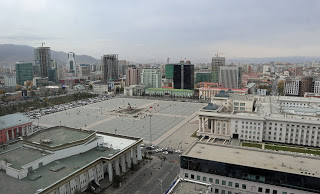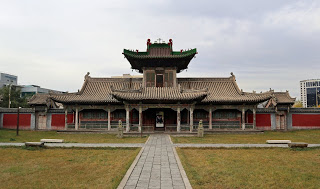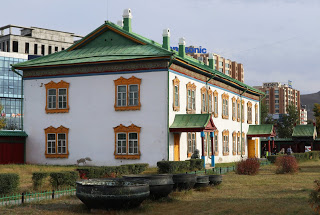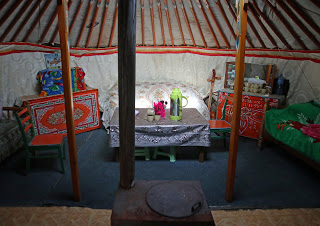Ulaanbaatar
Mongolia
Sept 28th – Oct 1st, 2019
I flew from Hong Kong to Ulaanbaatar, which is a 4-hour flight that arrived at 9:00 pm local time. Immigration formalities were very quick and easy. German and US passport holders can enter Mongolia without a visa, while most other EU members can get visas on arrival, although some (in particular UK citizens) have to get their visas in advance. After leaving the baggage hall I was approached by several touts offering taxi rides. I had read that this is fairly safe and common practice in this city, so I just followed one of the guys who seemed friendly. He asked for 40k MNT, which was probably a special tourist price, but I didn’t argue since it was only 15 USD. The currency in Mongolia is the Tugrik (also spelled Tögrög), with a current exchange rate of about 2,700 MNT to 1 USD. The ride to the city took only 20 minutes, as there was little traffic at that time. During morning and afternoon rush hour though this drive can easily take an hour or more. I stayed in the very nice and centrally located Khuvsgul Lake Hotel.
I had a couple of days to myself in Ulaanbaatar before my guided tour to Western Mongolia started and I used the time to explore the city. I began at the huge Sukhbaatar Square, which is overlooked by the large government palace and defines the center of this fairly compact town. The city is very walk-able with wide sidewalks and pedestrian crossings everywhere.
After a quick stop for coffee and my realization that almost all the museums are closed on Sundays (note that most attractions here have very different winter and summer opening schedules, and late September already counts as winter), I walked to the Gandan Monastery. It is a fairly unremarkable building, but it houses a very impressive and huge golden statue of Avalokitesvara. This is an important sculpture in Mongolian history, although the current version was built in the 1990s, after the original had been destroyed by Russian troops in the 1930s.
After lunch I went on a long walk to the Zaisan Monument, which is located on a hill just to the South of the city. This is a modern monument, which commemorates the Soviet soldiers killed in WWII. It was well worth climbing the many stairs to the top, not for the monument itself, but for the great views over the whole city.
Ulaanbaatar, or UB as most people refer to it, was founded in the 17th century as a Buddhist center for the then entirely nomadic population. UB is not what you would describe as a beautiful city, but it does have a certain charm to it, particularly since it is completely surrounded by mountains. Its architecture appears to be largely inspired by 1950s Soviet style. Although it is quite a clean city (you see people sweeping the streets everywhere), in the winter months it suffers from one of the worst air pollution problems in the world. This is due to a combination of electricity being produced by large coal power stations located right next to the city, and the fact that a significant proportion of the population still uses coal fired stoves for cooking and heating.
On my way back I still had time to stop at the Bogd Khan Palace, which was well worth it. It is a very elaborate set of Chinese temple style buildings surrounding two large court yards. It was the summer palace of the Bogd Khan, who became the leader of Mongolia in 1911, when it achieved independence from Qing dynasty China.
The adjacent winter palace is a European style building, with some very fine interior decorations, including an extensive collection of exotic stuffed animals.
On my second day in UB I had a Viator tour booked for a trip to see the Genghis Khan Equestrian Statue, which is located about 50 km east of the city. I was picked up from the hotel at 9:00 am by my guide Avaand and a driver. We spent quite a bit of time stuck in morning traffic, but it was interesting driving through the outskirts of the city. There was a lot of construction ongoing – huge apartment complexes going up, which by the looks of it will be mostly high-end luxury apartments. I was told they are all built on the western side of city, since that is where the wind comes from and thus the air pollution is not as bad in winter. After leaving the city, we drove through a very sparse and mountainous landscape. The mountains were completely bare, covered only with yellow grass (which apparently is green up until the middle of September). After about a 2-hour drive, we suddenly saw the huge monument sticking out in the middle of this empty landscape.
The Genghis Khan Equestrian Monument was erected in 2008 on the site, where according to legend Genghis Khan found a golden whip. It is a ridiculously enormous, shiny metal sculpture on top of a large circular building – a bit gaudy but certainly impressive. You can walk (or take the elevator inside) to get to the top of the horse’s head for a great view over the surrounding landscape.
After the monument we drove a bit further north into the Gorkhi-Terelj National Park, where we had lunch with a local family in a small village. We were picked up by ‘taxi’ pulled by this very large hybrid of yak and bull. Lunch was inside a very nicely decorated gher and consisted of some tasty meat filled bread and a soup of vegetable and mutton.
On the way back we came across one of the kids coming back from school, and this is how Mongolian children commute to school:
The park seems to be a very popular holiday destination, since we saw a large number of gher camps and hotels dotted along the road. Avaand told me that many Mongolians come out here from UB for the weekend particularly during the winter to escape the polluted air. It is also a popular weekend trip for Koreans, since UB is only a 3-hour flight from Seoul. Our last stop was the famous turtle rock, which really is remarkably shaped like a giant turtle.
For dinner I had my first taste of yak meat. I went to the rooftop restaurant in my hotel, a Korean BBQ restaurant, where you pick your piece of meat from the freezer and then cook it yourself on the table grill. However, they must have seen my confusion and hesitation when it came to grilling my own yak meat, so the waiter offered to do it for me, which was probably a good idea. It was quite a tough but really tasty meat.
On my last day in the city I had time to visit a couple of the museums. Two that are definitely worth seeing are the National Museum of Mongolia, which provides a good overview of the region’s history from prehistoric times to the present, and the Fine Arts Zanabazar Museum. Both are a short walk from the main square.
I would not call Ulaanbaatar a major tourist destination, but I would definitely recommend adding a couple of days in the capital when on a trip to Mongolia.























